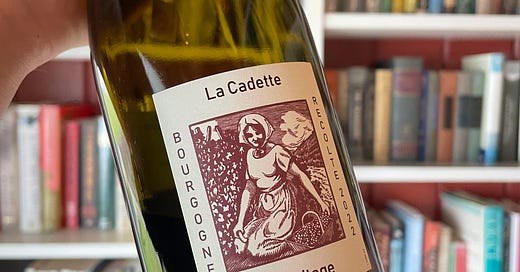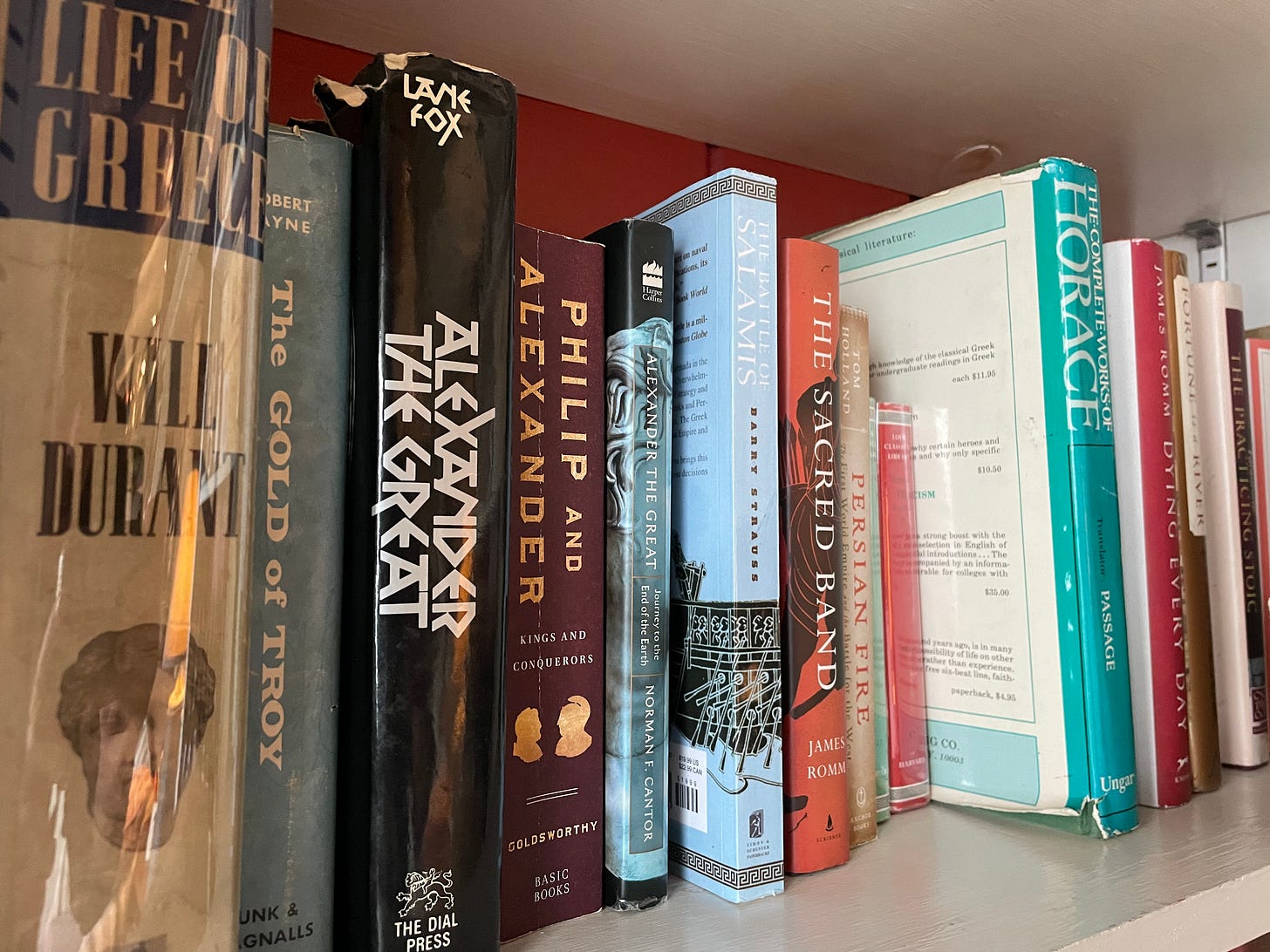I Get Bit by the Burgundy Bug
I get a chance to talk Julius Caesar, muse on a lesser known grape, and enjoy a Burgundy wine from importer Kermit Lynch.
Domaine de la Cadette L’Ermitage
Varieties: Pinot Noir, César
Region: Ermitage, Vézelay, Burgundy, France
Producer: Domaine de la Cadette / Valentin Montanet
Costs: $40-$45
I Get Bit by the Burgundy Bug
I get it. I can really understand the appeal of Burgundy as a region. Yet, working in an Italian specialty store, I can honestly say I lean towards more of those subregions rather than French ones. Piedmont, Tuscany, Sicily… the folks that have been following along here know where my rambles stem from. But tonight is a different story. A beautiful Burgundy red wine from the importer Kermit Lynch. Perhaps a new favorite, simplistic wine label out of those that I have seen recently. A label that conveys history, rusticity, and harmony all in one. This is all before we even touch on the wine itself. Liquid gold, smooth as a Sade song, and a flavor profile that screams PLACE. The wine itself says ‘Hey, I’m from this area. I represent this parcel in all of its glory’. A rare wine in the sense that it is not 100% Pinot Noir, as it includes a grape called César. Of course this will allow me to get into some history as well. I envision Ms. Frizzle getting aboard the Magic School Bus and taking everyone to Burgundy. Maybe these ramblings will give you a similar feeling.
First, let’s get to the wine itself. I can imagine myself going down some Roman Empire rabbit holes tonight, so I will provide the hard hitting details now. The wine is this beautiful garnet color. A vibrant red in the glass with just a touch of purple to it. Purple like the color of the Praetorian Guard… allegedly. There are a lot of elements in this wine - color, nose, and palate - that provide just a touch more ‘deepness’ to it because of the César. You get all of the freshness and grace of the Pinot Noir, with just a dash of power and grit from the César. It really is an intriguing wine in so many ways. So let’s get to the nose. It’s all very fresh, with a bouquet of dark cherries and blackberries. An abundance of fruit that gradually transitions to this earthy, moss covered forest floor. You have an aromatic finish of lavender and other French herbs. The wine hits a beautiful harmony in all respects, but especially that of the fruit and other tertiary, savory notes. It really does always come back to the fresh fruit, however, and I think you have the Pinot Noir to thank for that. I feel like I have been writing about the wine as though it were a 50/50 blend of the two grapes. I should clarify that the blend is 85% Pinot Noir and 15% César. Therefore, you are mostly getting Pinot Noir characteristics with this wine, but the addition of the other grape makes it a tad more fun.
So what is this other grape? César you say? Well, I will start with the established modern information and proceed backwards to the lore and history. Through recent DNA testing, it has been shown that César is a cousin grape to Barbera of Piedmont. Right there I already have another reason to love this wine. The grace, elegance, and lively aspect of the Pinot Noir combined with the dense and whole structure of the César. Barbera always has these lively tannins, tends to respond well to choices in cellar, and more than delivers on the dark fruit. I can see how these two grapes are related. Now how about the historical aspect of the grape César? Well, here is where I can talk about Julius Caesar and that period of Roman history, so strap in. I always told the students that it was presumptuous to think of a ‘unified’ Roman Empire. The Romans spent hundreds of years attempting to unify various peoples, tribes, and races under a common culture and structure of government. Even something like the island of Sicily, or the peninsular provinces related to the Umbri and Etruscans. The Romans had to fight numerous wars, culminating in the Social Wars, just to keep their allies placated on the peninsula. The Latin people basically said ‘Hey, if I have to send my men to fight in your wars and conquests, then we want the same rights as Romans!’. And they ultimately got those same rights. But I am straying away from Gaul and the grape of César. I bring all of these related events to the table because the conquest of Gaul by Julius Caesar is one of the most well documented pieces from this time in history.
The César grape only takes up a few acres in the northern tip of Burgundy. The ancient Romans used to hug the coast of the Mediterranean, through modern day Genoa into the Marseille area of France. From there, it was easy for them to spread north. However, it is always important to have strongholds on the coast, especially after the Romans won control of the Mediterranean from the Carthaginians. Geez, how fun is it that a wine can unlock so many historical conversational pieces. It is no shock that the Romans instituted the practice of viticulture in the areas they conquered. It may have been prevalent in some areas, but the Romans certainly instituted a methodology to it. And you know the funny thing? The methodology and recordings of vines, harvests, and certain grapes was due to the ration system of the Roman army. As the Roman Empire grew in size, they had to constantly recruit soldiers to maintain outposts and wage wars in far off regions. The deployment of those soldiers meant massive amounts of food, equipment, and wine it turns out. Certain areas in antiquity certainly stand out and Gaul is definitely one of them. After Caesar was able to subdue the Gauls, culminating with the capture of Vercingetorix, he left behind a legacy of vines and winemaking.
Flash forward two thousand years, and I can sit in my home enjoying a wine from Domaine de la Cadette that tells a story through the bottle. It’s allowed me to muse more on a favorite topic of mine, the Roman Empire, while also further exploring a world class region for wine. Oh, Burgundy, I wish I had met you forty years ago before I was even born. Maybe then I would have been able to populate my cellar with examples of your wines. Alas, I feel as though I may have missed the boat for this notable region. However, I could buy a half case of this L’Ermitage, and I think I shall. There are some stunning examples of Burgundy reds around the $50-$75 price point. Of course the real ‘notable’ producers, like a L’Enfant Jesus wine I was peeping the other day, will really set you back some cash. I suppose the same could be said for something like Super Tuscans, or Barolo crus, yet Burgundy seems to be in its own lane when it comes to price points. That makes this particular wine that much more intriguing! The fact that you can get a Burgundy, with an amazing story, and ability to drink now or hold should not be overlooked. All of this for less than $50… folks, this may become a hill I could die on. As I tell people on the retail end - if it is imported by Kermit Lynch, it will probably deliver and then some. At any price point. So I say go for it. If you already enjoy Burgundy wines, then allow this particular red to introduce you to an ancient and lesser known grape. If you, like me, have been somewhat intimidated by Burgundy then let this be a jumping off point. It is a way to get your toes wet, for enjoying an incredible wine, without breaking the bank. Always better to be pleasantly surprised and have the wine drink ABOVE its price point I always say. Plus, this wine is right in that sweet spot. For a truly special occasion or moment of enjoyment, I think $40 is well worth it for this wine. And thus we get to the moment of the curtains being drawn. I silently exit stage left with the wine there to take all the applause, as it deserves. Give a big hand for this well priced Burgundy that over delivers in every regard!






Love that you could tie in Ancient Greece and Rome! I know that is your favorite!!
Who needs Mrs. Frizzle to drive the magic school bus when we have you?! Wine, Julius Cesar, and beautiful writing, to boot.